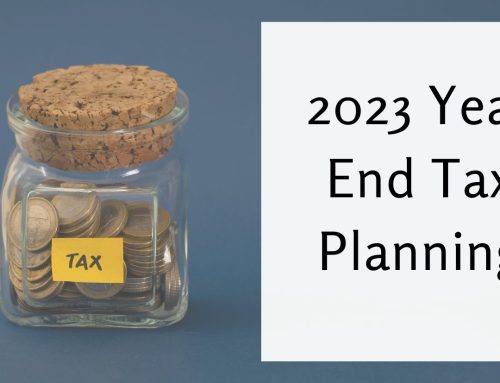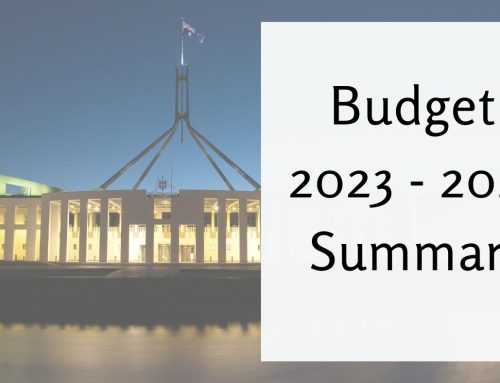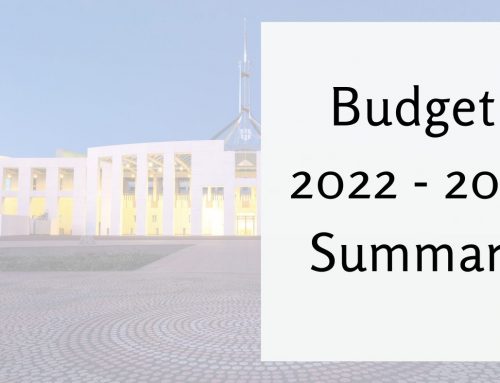Individuals
The 2021 – 2022 Federal Budget was handed down last night and it has been described as a labour style Budget given the level of spending. What does the Budget mean for you as an individual? Below are the main items that will impact you from a taxation perspective:
a. Resident Individual Marginal Tax rates
The changes to marginal tax rates arose from prior year Budgets so the announcement last night was simply a reinforcement that the tax cuts announced in the 2019 and 2020 Budgets will remain and be implemented according to the time table previously announced. The personal marginal tax rates for resident individuals are as follows:
For the years ending 30 June 2021, 2022, 2023 and 2024 are:
| $0 – $18,200 | Nil |
| $18,201 – $45,000 | Nil + 19% of the excess over $18,200 |
| $45,001 – $120,000 | $5,092 + 32.5% of the excess over $45,000 |
| $120,001 – 180,000 | $29,467 + 37% of the excess over $120,000 |
| $180,001 & over | $51,667 + 45% of the excess over $180,000 |
For the years ending 30 June 2025 and beyond the resident individual marginal tax rates are:
| $0 – $18,200 | Nil |
| $18,201 – $45,000 | Nil + 19% of the excess over $18,200 |
| $45,001 – $200,000 | $5,092 + 30% of the excess over $45,000 |
| $200,001 & over | $51,592 + 45% of the excess over $200,000 |
b. Non-Resident Marginal Tax Rates
The marginal tax rates for non-resident individuals for the period 1 July 2020 through to 30 June 2024 are:
| $0 – $120,000 | 32.5% |
| $120,001 – 180,000 | $39,000 + 37% of the excess over $120,000 |
| $180,001 & over | $61,200 + 45% of the excess over $180,000 |
The marginal tax rates for non-resident individuals for the period 1 July 2024 and beyond are:
| $0 – $200,000 | 30% | |||||||
| $200,001 and over | $60,000 + 45% of the excess over $200,000 |
c. Low & Middle Income Tax Offset (LMITO)
The Low & Middle Income Tax Offset (LMITO) that was introduced for the 2020 tax year has been extended for an additional tax year and will now be with us until 30 June 2022.
For those taxpayers with a taxable income of less than $37,000 the LMITO is capped at $255 and there are shading in provisions for those with taxable incomes between $37,001 and $48,000.
Those taxpayers whose taxable income is between $48,001 to $90,000 the LMITO is capped at $1,080. There are shading out provisions for those on income between $90,001 and $126,000. Any taxpayer with a taxable income greater than $126,000 will not be entitled to the LMITO.
d. Low Income Tax Offset (LITO)
The Low Income Tax Offset (LITO) remains unchanged from what was announced in the 2020 Budget. Eligibility to receive the LITO works as follows:
- If your taxable income is $37,500 or lower, the LITO is $700
- If your taxable income is between $37,501 and $45,000 the LITO is calculated using the formula $700 – ([Taxable Income – $37,500] x 5%)
- If your taxable income is between $45,001 and $66,668 the LITO is calculated using the formula $325 – ([Taxable Income – $45,000] x 1.5%)
- If your taxable income is greater than $66,668 you are not eligible to receive the LITO
e. Child Care Subsidies
With effect from 1 July 2022 (i.e. not next financial year but the following year) the child care subsidy available to families with more than one child aged 5 and under in child care will increase by 30% for the second and third child. In addition, the Government has mandated to remove the $10,560 cap on the Child Care Subsidy.
f. Primary Residency Test for Individuals
The Government has proposed that the existing tax residency tests for individuals will be replaced with a primary test whereby a person who is physically in Australia for at least 183 days in any income year will be considered to be an Australian tax resident for that income tax year. If an individual were to fail the 183 day test then there will be a secondary test that will be more objective and will be based on a combination of physical presence in Australia and other criteria. Based on case law this secondary test will be based on the individual facts of that individual.
g. Employee Shares Schemes
Under the existing rules for employee share schemes (ESS) an employee who defers the taxing point on any employee shares when granted is taxed at a future point in time. Termination of employment is an event that causing the taxing point on the employee shares to be incurred. The Government has announced that they will remove termination of employment as a potential taxing point. Under the new rules the taxing point can extend beyond termination of employment to the earliest of:
- For shares – when they are no longer subject to a real risk of forfeiture and/or have no genuine sales restrictions
- For rights/options – after the exercise of the options where the shares are no longer subject to a real risk of forfeiture and/or genuine sales restrictions
There will be a maximum deferral period of 15 years from the date the shares/options were granted.
Businesses
As we said in our 2020 Federal Budget newsletter last year, the Government missed an opportunity to assist the hospitality and entertainment sectors by not abolishing the Fringe Benefits Tax regime (FBT). As FBT only accounts for approximately 1% of the Government’s revenue it would have been an opportunity to promote economic activity in that sector. This Budget was also a missed opportunity for these sectors especially when you consider the number of small businesses that could be positively affected. While businesses and employees may take advantage of the removal of the FBT regime, the solution may be to exempt meal and entertainment fringe benefits up to a limit based on a percentage of turnover/sales.
There was not much in the Budget for small to medium sized businesses.
The following is a summary of what we believe to be the main announcements that will affect businesses:
a. Temporary Full Expensing of Depreciable Equipment until 30 June 2023
The full expensing of depreciable equipment has been extended by 12 months such that it will now cease on the 30 June 2023 (rather than 30 June 2022).
Eligible businesses are able to deduct the full cost of eligible depreciating assets acquired after 6 October 2020 and first used or installed ready for use by 30 June 2023.
b. Temporary Loss Carry-Back Rules Extended to 30 June 2023
The Government announced that the temporary loss carry-back rules will be extended for a further 12 months such that the loss carry-back rules can be used up until the 2023 tax year.
Companies with an aggregated annual turnover of less than $5b can carry back losses incurred in an eligible tax year against profits derived in a previous tax year to generate a taxable refund. Tax losses incurred by an eligible business in the 2020, 2021, 2022 and/or the 2023 tax year can be offset against previously taxed profits as far back as the 2019 tax year.
The loss carry-back provisions cannot be accessed if the utilisation of these rules would cause a company’s Franking Account to go into deficit. If you choose not to utilise or are not in a position to utilise the carry-back loss provisions then the losses incurred will continue to be carried forward and available to be used subject to the normal provisions regarding the recoupment of prior year tax losses.
c. Superannuation Guarantee Charge
- Under the current rules, if an employee does not earn at least $450 in a month, the employer is not required to make any superannuation contributions on that employee’s behalf. Last night the Government announced that it will remove this minimum income threshold. This means that employers will now have to pay the Superannuation Guarantee Charge (SGC) for all employees irrespective of the amount earned in a particular month.
- There was no change to the previously legislated SGC rates. This means that from the 1 July 2021 the SGC rate payable by employers will increase from 9.5% to 10%. This rate will then continue to increase each year by 0.5% until it reaches 12% for the 2026 tax year.
Superannuation
At first glance there did not seem to be much in the budget in relation to superannuation. However, there are some key changes announced that will assist clients and these are:
a. Repealing the Work Test for Voluntary Contributions
At present if a person aged 67 to 74 wishes to make a non-concessional contribution to superannuation they are unable to do so unless they satisfy the work test which requires that person to have worked, for reward, for a minimum of 40 hours in a 30 day consecutive period. The Government announced in the Budget last night that they would remove the work test for those aged 67 to 74 so these people can continue to make non-concessional superannuation contributions.
Importantly, the existing contribution caps remain and you must ensure that any contributions are within the existing caps. The non-concessional cap for 2021 is $100,000 per person and for the 2022 tax year and beyond this non-concessional cap will increase to $110,000.
b. Changes to Residency Rules
Presently if you are a member of a SMSF and you temporarily relocate overseas you have a two year window in which you can continue to manage your superannuation fund without breaching the residency rules. After the two years has expired, if you wish to maintain the self managed superannuation fund (SMSF) you must appoint an attorney (having been appointed under a Power of Attorney) to take your place as the individual trustee or the director of the corporate trustee.
The Government announced in the Budget that this 2 year residency test will be extended to 5 years. This is a welcome change and hopefully will be enacted shortly.
c. Reducing the Age for Downsizer Contributions
The Government introduced “Downsizer” contribution rules which allowed persons aged 65 or above to contribute up to $300,000 each to their superannuation from the proceeds of the sale of their main residence if they had owned their main residence for a period of 10 years or more. In last night’s budget it was announced that the eligibility age will be reduced from 65 years of age to 60 years of age.
d. SMSF Legacy Pensions
Many years ago now the Government at the time removed the ability of SMSFs from commencing a variety of life time retirement income stream products that could be accessed by those in retail and industry funds. For those who entered into such products prior to the changes they are most likely in their last 70s or older. The attraction for using such products was usually related to the concessional Centrelink treatment that would enable them to qualify to receive an aged pension.
In the Budget last night it was announced that the Government will offer members of SMSFs with these legacy pension products a two year window to exit these pensions (and any associated reserves). Members will be able to commute these pensions, transfer them back to accumulation phase and then commence an account based pension. This will present an opportunity for members of SMSF with these products to re-assess their retirement pensions and their retirement strategies.
However, while this is an opportunity to restructure your pension. Much thought must be given to the implications of commuting such legacy income streams as the Government stated that the social security and taxation treatment will not be grand-fathered. Any commuted reserves will be taxed as an assessable contribution.
As with any re-assessment of retirement income stream strategies, the impact on your Transfer Balance cap must be considered prior to undertaking any changes to existing arrangements.
e. First Home Super Saver Scheme
The maximum releasable amount of voluntary concessional and non-concessional contributions under the First Home Super Saver Scheme will increase to $50,000 (up from $30,000). Any contributions made from 1 July 2017 up to the existing limit will count towards the amount able to be released.
If you would like to discuss how the 2021 – 2022 Federal Budget may impact you please contact our office.





